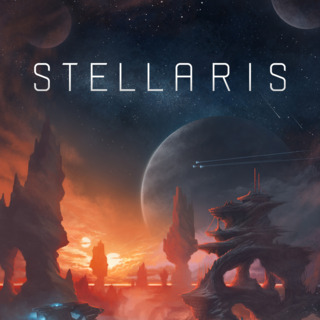INTRO:
Leviathans added reasons to explore the galaxy in playthroughs, but was also criticized for not doing things that are particularly significant or radical. Along with some incidents that probably rankled the game’s designers and gave them some crazy ideas, many of the later expansions introduce content that offers very different gameplay – so different that gameplay balancing and documentation of gameplay elements became major issues.
Distant Stars is a return to the design philosophy behind Leviathans. The impression that this is the case is made all the stronger with the introduction of additional kinds of Leviathans.
However, the stars of this content – pun very much intended – are the special star systems that are added into any playthrough with Distant Stars content included.
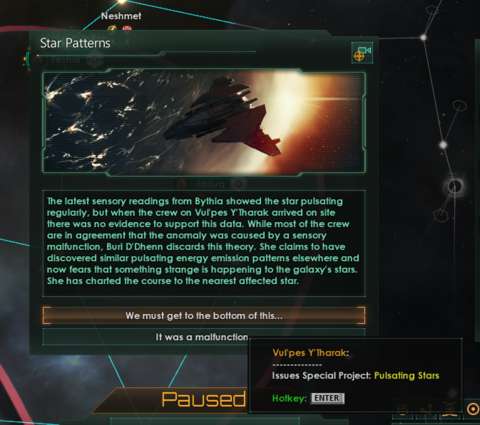
ADDITIONAL ANOMALIES ADDED TO BASE GAME:
The Niven update that came alongside the Distant Stars DLC revamped the system for the studies of anomalies. The outcomes of the studies will never be decided with an RNG roll, and will have fixed results instead, which is good. For the gameplay-balancing of anomalies, anomalies with more desirable outcomes have much longer studying times instead. Therefore, players would have to decide between having science ships and their scientists spend precious time on studying discovered anomalies or having them continue surveys.
(A tip here: it might be wiser to consider continuing surveys, if one of the player’s goals is to claim systems. After all, only fully surveyed systems can be taken.)
To encourage players to start new playthroughs, additional anomalies have been added to the base game.
AZIZIANS:
However, a few anomalies are exclusive to Distant Stars content. These involve the discovery of the Azizians; the Azizians would have been another pre-sapient species – except that they are also gigantic slugs revived from frozen stasis. Depending on the player’s choices, they could become yet another sapient species (albeit with two potent positive traits that are inherent), or a variant of the Titanic beasts that causes less collateral damage, but has less morale and costs Energy to be raised too.
ADDITIONAL LEVIATHANS:
Like the Leviathans in Leviathans, most of the additional Leviathans that Distant Stars introduces are extant creatures, already placed in the galaxy at the start of the playthrough. They wait around until they are discovered – usually killing whatever discovered them in the process.
The Scavenger is another massive automaton, not unlike the Automated Dreadnaught. However, it is not salvageable in any way, because it is already a barely held-together garbage processor in the first place. The reward for defeating it is the best self-repair tech for ships in the game.
Next, there is the Tiyanki Matriarch. Unlike the ambivalent Tiyanki Space Whales, this one is hostile and eagerly wrecks any ships that it comes across. Of course, it is also much bigger and more powerful than other Space Whales. Fortunately, it stays within its home system, unlike Space Whales and their predators, the Space Amoeba. (It will kill Space Amoeba that it comes across, of course.) The reward for defeating the Matriarch depends on what the player does with the crewed ship that managed to survive in its gullet.
One of the additional Leviathans will be described in its own section, because of the unpleasant way that it makes itself known.
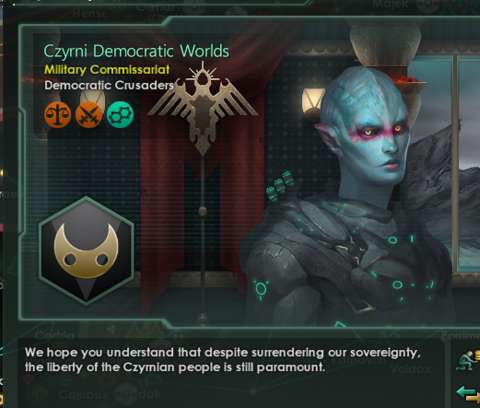
VOIDSPAWN:
Unlike the other Leviathans, the Voidspawn’s presence is hidden. Specifically, it is hidden in one of the planets in the galaxy. At this time of writing, the only hints of the whereabouts of this planet is its climate and its star type; even so, there would be quite a number of planets with such circumstances, which have to be learned from sources outside the game anyway.
The Voidspawn’s scripting triggers when the star system with the planet is taken. After a few in-game years, the planet undergoes changes; the civilization that has the system receives an alert of this. If the civilization has colonized the planet, this “alert” can be unpleasant; the colony planet suffers considerable damage and rifts appear as tile blockers. Another change happens afterwards, this one even more distressing than the last. This is a warning to the civilization that perhaps the colony should be abandoned.
Finally, the stricken planet cracks open to reveal the voidspawn, an immense monster that could theoretically rival even the Ether Drakes.
On the other hand, the Voidspawn is perhaps the most badly designed of the space monsters, in terms of its combat performance. This is because it has no diversity whatsoever in its “weapons”, which are all of the guided type, i.e. missiles. With enough point-defence weaponry, the Voidspawn is very much doomed to lose a battle of attrition.
(It is unclear whether the Voidspawn would be able to breed or not, even though it is said to come from a planet-sized egg. There is plenty of speculation among fans of the game, of course.)
CURATOR ENCLAVES INCLUDED TOO:
Since dangerous space monsters and monolithic automatons are involved, the content for the Curator Enclaves came together with the content for Distant Stars too; the other Enclaves are not included. The Curator Enclaves provide their usual services, in addition to giving advice on the Leviathans that this expansion introduces.
However, they do provide one additional service: assistance regarding the L-Cluster, which is the main feature of the expansion. This will be described shortly.
L-CLUSTER - FOREWORD:
The L-Cluster’s existence is revealed when a civilization comes across an L-Gate. These are like the Gateways, but scans would show that they are quite different and appear to all link to the same destination – a cluster of stars far outside the galaxy. This also strongly suggests that anything there is far older than anything in the known galaxy. Getting there is a considerable undertaking though, and handling what is revealed is another matter too.
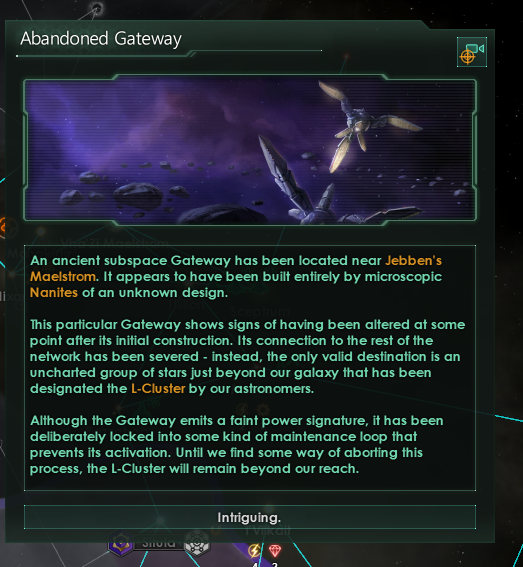
L-GATE INSIGHT:
Not unlike the Precursor event chain, a civilization has to collect pieces of a puzzle before being able to continue the event chain. The L-Gates are ancient things, so there are some secrets to be found out there. These are “Insights” on how the gates work.
Some Insights are obtained like Precursor Artifacts, being found from studying anomalies or other surveys of Science Ships. Alternatively, they can be obtained through research, but at the cost of not researching something else, of course. Finally, they can also be purchased from the Curators, but only once every several years because the Curators have to strain their computers for this ancient knowledge.
After enough Insights have been found, the player is given a choice: save the Insights for use on opening an L-Gate, or abandon the search and gain considerable Science points from each piece of Insight. Most players would likely go for the former.
OPENING AN L-GATE – AND CONSEQUENCES:
The next step is to find and claim a system with an L-Gate. After it is activated with a Science Ship, the L-Cluster is revealed, together with what it portends for the galaxy. There are several possible permutations: the onslaught of the Gray Tempest, the revelation of an ancient civilization, the migration of L-Drakes, or the L-Cluster is simply desolate. Each case will be described in its own section.
In all cases except the last, the other L-Gates would be automatically activated, allowing every civilization with an L-Gate to reach Terminal Egress, the first star system in the L-Cluster.
L-CLUSTER SYSTEMS & GRAY RESOURCES:
The L-Cluster has stars that are apparently still around, though depending on its seeding code, some systems may have a peculiar number of black holes and other debilitating stars.
The main attractions of the L-Cluster are the special resources in it; these are exclusive only to Distant Stars content. These are sources of ancient nanotechnology, but they are implemented like strategic resources: one increases the potency of weaponry, one increases research speed (not unlike Dark Matter), one increases terraforming costs but accelerates it and one increases food output (apparently this nanotechnology can restore biospheres). Obviously, these alone encourage the capture of the L-Cluster systems – if any threats had been dealt with.
GRAY TEMPEST:
The first case of opening the L-Gates is the worst one, and unfortunately there is no in-game forewarning of this. Opening the L-Gates unleashes fleets of nanotech ships, which go on to ravage the galaxy, turning habitable worlds into ones hostile to life. The Gray Tempest is not unlike the Contingency end-game crisis.
However, unlike end-game crises, this can happen early – which effectively dooms the galaxy. Of course, if the player is powerful enough, he/she can just let them ravage the galaxy until his/her civilization is the only one left.
The reinforcement fleets can only ever enter the rest of the galaxy through Terminal Egress, so if a civilization is strong enough to lock down that star system, their extant fleets would eventually be whittled down – if they are not overly powerful for the rest of the galaxy, of course.
Furthermore, the civilization that opened them (usually the player’s) is informed of a critical weakness in the nanotech invaders: their main hub. If it is destroyed, their nanotechnology becomes inert and they turn to dust. Any worlds that they have ravaged can be terraformed, if there are resources to do so.
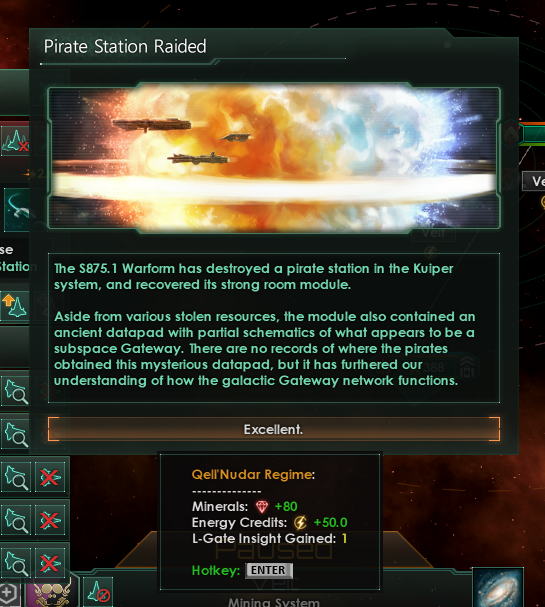
GRAY EMPIRE:
In the case of the revelation of an ancient civilization, all of the L-Cluster systems are under its control. It is also wielding nanotech fleets, and all of its colonies are fruitful Gaia worlds.
The first contact with them makes a strange first impression. Communications start awkward at first, before eventually settling down to something like the communications with the Enclaves. It is happy to give a unit of each of the Gray strategic resources to whoever opened up the L-Cluster; this is implemented via a civilization-wide modifier, instead of a trade deal.
They request that guests stay out of the only trinary star system in the L-Cluster; civilizations with long-ranged sensors might notice that it has a main hub there, not unlike the one in the first case. Trespassing there, or enquiring too much about the origins of their nanotechnology, makes the ancient civilization permanently hostile and incommunicado. The sad truth is revealed if they are defeated.
L-DRAKES RELEASED:
The L-Gates open up, and for each one, a smaller version of the Ether Drake bursts through. The L-Drakes are not hostile, however, and would instead “swim” about the galaxy before becoming bored and stupidly lost. They then settle down in wherever systems they are, even if it is the territory of a civilization.
Xenophobic or genocidal civilizations can just outright kill them and gain some Influence in the process, while also processing their corpses for Minerals. Indeed, this is the only thing such civilizations can do. (The civilization that opened the gates also gains more rewards if it went this route.)
As for the other civilizations, they may attempt to tame the L-Drakes with Science Ships. Doing so has them joining as space muscle.
GRAY:
The seemingly least exciting outcome of opening the L-Cluster is that it is just dead and abandoned. Curiously though, the other L-Gates have their activation delayed. Thus, the civilization that made the first move has a headstart in capturing the star systems in the cluster – preferably starting with Terminal Egress.
In build 2.1.3 (and not 2.1.0, which is the build number for the Niven update and the release of Distant Stars), an additional bonus is added to this case when the galaxy is generated. This can be had, if the player is fast enough.
One of the nanotech-infested worlds in the Cluster happens to have a special anomaly. When investigated, the last sentient remnant in the Cluster reveals itself – in the form of an individual of the same primary species as the civilization that found it. After introducing itself as “Gray”, It asks to join.
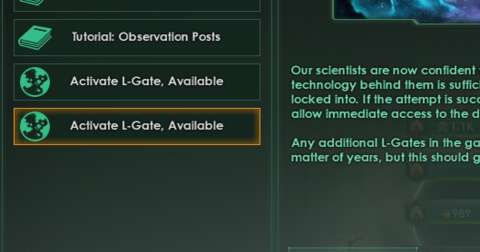
It is important to keep in mind that finding Gray is a “finder’s keepers” matter. The other civilizations will be sending their own science ships into the Cluster too, and there is a chance that they might find Gray first. Closing borders might help, but subject civilizations cannot be kept away.
Afterwards, Gray can be asked to assume one of three forms, whenever convenient. It can take on the form of a level 10 Governor that is practically immortal and incredibly efficient – perfect for peace-time work. During war-time, Gray can be asked to change to one of two more suitable forms – a nanotech “war-form”, which has the highest damage output among armies in the entire game, or a nanotech super-heavy ship, which is practically the most powerful player-controllable space vessel in the game.
Gray pretty much breaks the game. On the other hand, if Gray joins one of the other civilizations, the player might well have a problem.
The caveat here is that whenever Gray changes forms, it returns to the capital planet of the civilization that it joined. This might mean that it may not be able to respond to threats elsewhere in time, unless the civilization (likely a far-sighted player’s) has developed a network of Gateways.
ENIGMATIC CACHE:
Most ancient automatons are lethally destructive things, but Distant Stars introduces a peculiar specimen. This is the Enigmatic Cache. The Cache drifts from one colony to another across the galaxy, seeking to scan every colony thoroughly. It lingers at each planet for a few in-game years.
When it is first encountered, a civilization has the choice of letting it do its thing, or drive it away. The Enigmatic Cache is not a particularly powerful automaton, so it could be defeated rather easily. However, it will return anyway, thanks to its mysterious technology, but would no longer bother itself with the civilization that tried to destroy it.
Letting it do its thing leads to some useful benefits, as long as the civilization is not Xenophobic; if it is, it gets the same benefits as the others, but also some Happiness penalties to whichever colony that the automaton is observing. During this time, the Cache can have its data tapped into; gameplay-wise, this gives a considerable bonus to the Science output of the colony.
Its pathing across the galaxy is slightly erratic, but eventually, it will account for all colonies. Afterwards, it decides to go to one of the weaker civilizations. It offers to provide benefits to the primary species of the civilization in order to improve its competitiveness.
Of course, if the Cache comes to the player and offers its help, this is because the player is either a terribly inexperienced rookie or an achievement-hunting completionist that is being deliberately terrible.
Anyway, this endeavour is not without problems. A technical issue happens halfway through the process; this is a warning that it might not turn out well. Choosing to fix the issue increases the chances of a positive outcome, but the civilization can also choose to abort the process without any problems (albeit the Cache considers the civilization to be a lost cause).
If the process is allowed to complete, there might be one of three outcomes. One of them is terrible, in which all populations of the primary species are rendered quite mad from the process, severely reducing their ability to produce Science points. This is usually a good point to consider save-scumming.
The other two outcomes are positive, but one of the positive traits that are granted appear to complicate species modification.
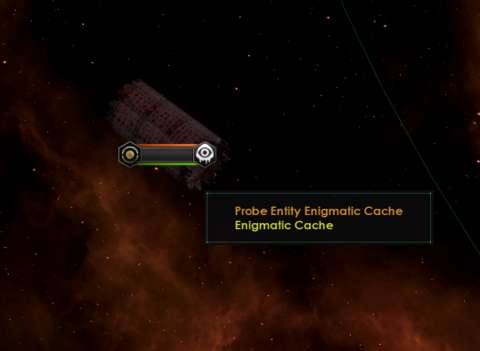
OTHER LESSER DISCOVERIES:
There are lesser discoveries that are not as significant as the L-Cluster or the Leviathans. Still, they serve to continue some design policies and habits of Paradox’s designers. For example, there are more pre-FTL civilizations with stories of their own, often making references to some sci-fi stories.
Perhaps the most significant – and amusing – of these is a civilization of rat-like creatures. Unlike the other pre-FTL civilizations, when they do emerge as a full civilization, they emerge with considerable military assets and own all habitable planets in their system, if it is not taken already.
Some of these discoveries use some assets from previous expansions. This might be a subtle way of enticing the player to get those previous expansions, if he/she has not done so already.
ADDITIONAL SPECIES TRAITS:
Some Distant Stars content introduces additional species traits. These often occur through event chains and special research projects.
For example, there is the Brain Slug Host trait. This is obtained from finding a world that is inhabited by a regressed species, and slugs that are actively trying to hide from them. Studying the slugs eventually lead to the choice of letting people attach the slugs to themselves, or stopping such a thing from happening in the first place.
However, if the civilization allows it, a new sub-species is created, having the brain slugs attached. The trait can then be added to any other sub-species from that moment on. Thus far, there is no known consequences for the proliferation of these traits, at least at this time of writing. (Fans are speculating that this might allow a civilization to convert to a Hive Mind.)
REFERENCES:
Even for an expansion with content that mostly takes place outside of the galaxy, Distant Stars cannot escape the infiltration of references that Paradox’s designers like so much. The first example is that the Tiyanki Matriarch’s story arch is a reference to Moby Dick.
Distant Stars adds two pre-FTL civilizations within the same star system. Both have Tomb Worlds, and one of them yields an anomaly that when studied, reveals that this piece of content might be yet one more reference to Star Trek.
The pervasiveness of nanotech in the L-Cluster and what happened to the worlds in them is a reference to the “Grey Goo” doomsday scenario that Eric Dexler described.
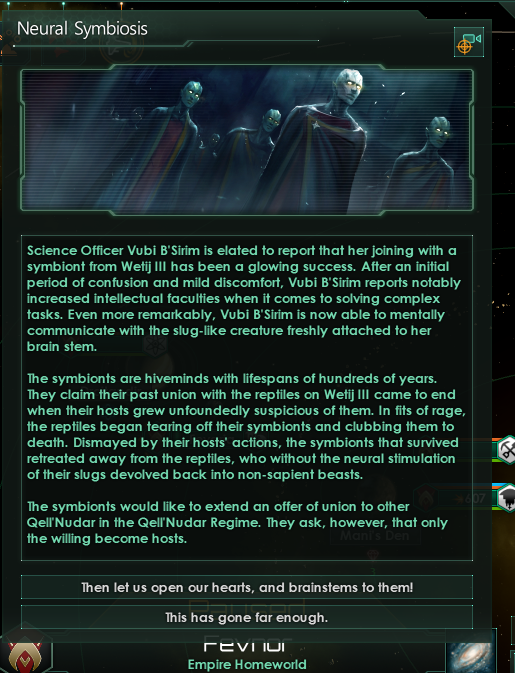
AESTHETIC DESIGNS:
In the Voidspawn event chain, watching an entire planet somehow changes in appearance as the gestation progresses can be entertaining. At the final stages, the planet certainly looks putrid. Of course, there is also the Voidspawn, which looks like a monstrous moth. However, the L-Drakes are a disappointment because they are practically reused assets.
The Nanite Worlds have boring textures, though perhaps being all gray is understandable considering that they are overrun with ash-like nanotech. The static artwork for them is more impressive, though there had been other sci-fi nanotech that looks prettier (such as Dust from Endless Space).
The Gray strategic resources uses remixed icons, which can seem lazy. Of course, this has been a minor problem since the debut of Stellaris.
The nanotech ships are not particularly impressive though. They have muddy textures and shapes that have too many edges. Perhaps these are the best impressions that Paradox’s artists can think of when they visualize ships that are entirely made of nanotech.
Distant Stars also includes a few more animated portraits. For example, there is a portrait for a humanoid species that more than resemble Klingons. Their harsh voice-acting would also be an all too familiar reference to that sci-fi classic.
CONCLUSION:
There is not much of anything that significantly diversifies gameplay in Distant Stars. Rather, it offers content that is more about gratification than sophistication. Nevertheless, after the rather exhausting complexity that Utopia, Synthetic Dawn and Apocalypse have introduced, Distant Stars would be a palette cleanser for ardent followers of Stellaris.
